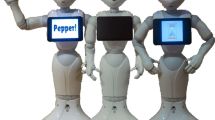Abstract
In this paper, we present three experimental studies in which subjects trained a robot to do a card game via reinforcement learning. In the first two studies participants interacted with the robot either without any learning ability (control group) or with one out of three versions of a learning algorithm implementing gradually aspects of more humanlike learning abilities. Results show that the implementation of a learning algorithm had positive effects regarding the evaluation of the robot, its learning abilities and the interaction. We found that more humanlike learning abilities do not always lead to better performance and evaluation and that results were to some extend influenced by longer or shorter interaction times. In a third study, we additionally explored the influence of other behavioral variations such as low or high verbal skills and interaction modalities in perceived intelligence of the robot irrespective of the implemented learning algorithm, but did not find significant effects. Results are discussed with regard to the socialness of future interaction scenarios.










Similar content being viewed by others
References
Schaal S (1999) Is imitation learning the route to humanoid robots? Trends Cogn Sci 3:233–242
Nicolescu MN, Mataric MJ (2003) Natural methods for robot task learning: instructive demonstrations, generalization and practice. In: Proceedings of the second international joint conference on autonomous agents and multiagent systems. ACM, pp 241–248
Argall BD, Chernova S, Veloso M, Browning B (2009) A survey of robot learning from demonstration. Robot Auton Syst 57(5):469–483
Billard A, Calinon S, Dillmann R, Schaal S (2008) Robot programming by demonstration. In: Siciliano B, Khatib O (eds) Springer handbook of robotics. Springer, Berlin, pp 1371–1394
Clouse JA, Utgoff PE (1992) A teaching method for reinforcement learning. In: Proceedings of the ninth international conference on machine learning (ICML92), pp 92–101
Thomaz AL, Breazeal C (2006) Reinforcement learning with human teachers: evidence of feedback and guidance with implications for learning performance. AAAI 6:1000–1005
Hoefinghoff J, Rosenthal-von der Pütten A, Pauli J, Krämer N (2015) You and your robot companion—a framework for creating robotic applications usable by non-experts. In: Proceedings of the 24th IEEE international symposium on robot and human interactive communication, pp 615–620
Meltzoff AN (1988) Infant imitation and memory: nine-month-olds in immediate and deferred tests. Child Dev 59:217–225
Minsky M (1975) A framework for representing knowledge. In: Winston PH (ed) Psychol Comput Vis. McGraw-Hill, New York, pp 211–277
Dube WV, McIlvane WJ, Maguire RW, Mackay HA, Stoddard LT (1989) Stimulus class formation and stimulusreinforcer relations. J Exp Anal Behav 51:65–76
Sloutsky VM (2003) The role of similarity in the development of categorization. Trends Cogn Sci 7:246–251
Calinon S, Guenter F, Billard A (2007) On learning, representing, and generalizing a task in a humanoid robot. IEEE Trans Syst Man Cybern B Cybern 37:286–298
Hester T, Quinlan M, Stone P (2010) Generalized model learning for reinforcement learning on a humanoid robot. In: IEEE International conference on robotics and automation (ICRA), pp 2369–2374
Hoefinghoff J, Rosenthal-von der Pütten AM, Pauli J, Krämer N (2015) “Yes dear, that belongs into the shelf!”—exploratory studies with elderly people who learn to train an adaptive robot companion. In: Proceedings of the international conference of social robotics, pp 235–244
Sutton RS, Barto AG (1998) Reinforcement learning: an introduction. MIT Press, Cambridge
Tapus A, Mataric MJ (2008) Socially assistive robots: the link between personality, empathy, physiological signals, and task performance. In: AAAI spring symposium: emotion, personality, and social behavior, pp 133–140
Tapus A, Tapus C, Mataric MJ (2008) User robot personality matching and assistive robot behavior adaptation for post-stroke rehabilitation therapy. Intell Serv Robot 1:169–183
Kober J, Bagnell JA, Peters J (2013) Reinforcement learning in robotics: a survey. Int J Robot Res. https://doi.org/10.1177/0278364913495721
Hoefinghoff J, Pauli J (2012) Decision making based on somatic markers. In: Proceedings of the 25th international Florida Artificial Intelligence Research Society conference. AAAI Press, pp 163–168
Hoefinghoff J (2015) A decision making framework for robot companion systems usable by non-experts, PhD dissertation, Lehrstuhl Intelligente Systeme, Universität Duisburg-Essen, Duisburg
Damasio A (1994) Descartes error: emotion, reason, and the human brain. Putnam Press, Mahopac
O’Doherty JP (2004) Reward representations and reward-related learning in the human brain: insights from neuroimaging. Curr Opin Neurobiol 14:769–776
Wunderlich K, Rangel A, O’Doherty JP (2009) Neural computations underlying action-based decision making in the human brain. In: Proceedings of the National Academy of Sciences, vol 106, pp 17 199–17 204
Zeelenberg M, Beattie J, Van der Pligt J, de Vries NK (1996) Consequences of regret aversion: effects of expected feedback on risky decision making. Organ Behav Hum Decis Process 65:148–158
Blais AR, Weber EU (2006) A domain-specific risk-taking (DOSPERT) scale for adult populations. Judgm Decis Mak 1:33–47
Acknowledgements
We thank Prof. Josef Pauli for his support and advice and for the Nao he kindly provided us with. Moreover, we would like to thank Christina Müller, Patrick Pecak and Svea Delsing for their help in data acquisition.
Author information
Authors and Affiliations
Corresponding author
Ethics declarations
Ethical Standard
APA ethical standards were followed in the conduct of the study.
Conflict of interest
The authors do not have any interests that might be interpreted as influencing the research. The authors declare that they have no conflict of interest.
Rights and permissions
About this article
Cite this article
Rosenthal-von der Pütten, A.M., Hoefinghoff, J. The More the Merrier? Effects of Humanlike Learning Abilities on Humans’ Perception and Evaluation of a Robot. Int J of Soc Robotics 10, 455–472 (2018). https://doi.org/10.1007/s12369-017-0445-4
Accepted:
Published:
Issue Date:
DOI: https://doi.org/10.1007/s12369-017-0445-4




